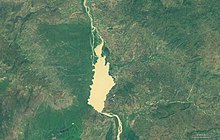| Kiri Dam | |
|---|---|
 Satellite photo of Kiri Dam Satellite photo of Kiri Dam | |
| Country | Nigeria |
| Location | Shelleng, Adamawa State |
| Coordinates | 9°40′47″N 12°00′51″E / 9.67972°N 12.01417°E / 9.67972; 12.01417 |
| Dam and spillways | |
| Type of dam | Earth fill dam |
| Impounds | Gongola River |
| Height | 20 m |
| Length | 72.2 km |
| Reservoir | |
| Creates | Kiri lake |
| Total capacity | 615 million m³ |
The Kiri Dam is in Shelleng local government area of Adamawa State in the north east of Nigeria, damming the Gongola River. It is a 1.2 km long, 20 m high zoned embankment with an internal clay blanket. The dam was mainly completed in 1982. The reservoir has a capacity of 615 million m³.
Savannah Sugar Company
The dam was built to provide irrigation for the Savannah Sugar Company (SSC), a large-scale sugar cane plantation and processing company set up as a joint venture between the Nigerian Federal Government and the Commonwealth Development Corporation (CDC), London. The CDC was managing agent for the project, and the construction contract was awarded to NECCO, a company largely owned by the government.
The Savannah Sugar Company was acquired by Dangote Industries in 2002. In 2009 the company owned 32,000 hectares of land near the dam or which 6,330 were in use and employed about 5,000 people. The company was producing about 50,000 tons of sugar annually, supplying the Nigerian market which consumes 1.1 million tons each year. Over 1,000 hectares of irrigated rice and other crops were being grown using the company's canals.
Flood
2015 Flood
In 2015, seven different communities were flooded in Adamawa State following the heavy overflow of water from Kiri Dam located in the state. In an attempt to ensure safety for the victims, Adamawa State Emergency Management Agency under the leadership of Mr. Haruna Furo provided a rescue camp that accommodated the victims. However, there was no recorded death from the massive flood.
Impact
29,000 hectares of land were expropriated without compensation, eventually displacing 20,000 people. Resettlement assistance was inadequate. The dam has affected the lower reaches of the Gongola River. Flood peaks dropped from 1,420 m³/second to 1,256 m³/second, while flows in dryer seasons increased from 5.7 m³/second to 21 m³/second. The river downstream from the dam has narrowed and become less winding, with fewer separate channels.
The people living in communities around the dam use it daily. They use it for fishing, bathing, washing and collecting water for general use. The dam also brings about environmental and health issues for those communities. There have been flooding, soil erosion, destruction of farmlands and buildings, dysentry, malaria, typhoid, skin diseases and cholera.
Future
An assessment of the dam in 2004 rated its condition "good". In October 2008 the United States Trade and Development Agency issued a request for proposals on constructing a 35 MW hydro-electric power plant at the dam.
References
- Bobboi, Ibrahim; Umar, Auwal; Oliver, Kadmiel (13 February 2021). "Assessment of Environmental and health problems caused by Kiri dam in Kiri area, Shelleng Local Government Area of Adamawa State" (PDF). International Journal of Advances in Engineering and Management (IJAEM). 3 (2): 73–78. ISSN 2395-5252.
- Institution of Civil Engineers, ed. (1990). Geotechnical instrumentation in practice: purpose, performance and interpretation : proceedings of the Conference Geotechnical instrumentation in civil engineering projects. Thomas Telford. p. 404. ISBN 0-7277-1515-1.
- ^ Enplan Group (September 2004). "Review of The Public Sector Irrigation in Nigeria" (PDF). Federal Ministry of Water Resources / UN Food & Agricultural Organization. Archived from the original (PDF) on 2017-05-18. Retrieved 2010-05-21.
- ^ Samuel G. Egwu (1998). Structural adjustment, agrarian change, and rural ethnicity in Nigeria. Nordic Africa Institute. pp. 87–89. ISBN 91-7106-426-5.
- "Inside Nigeria's only sugar factory". Daily Trust. 21 July 2009. Retrieved 2010-05-21.
- www.premiumtimesng.com https://www.premiumtimesng.com/regional/nnorth-east/189271-7-communities-submerged-in-adamawa-flood.html?tztc=1. Retrieved 2023-07-05.
{{cite web}}: Missing or empty|title=(help) - Terminski, Bogumil "Development-Induced Displacement and Resettlement: Theoretical Frameworks and Current Challenges", Indiana University, 2013, available at: http://dlc.dlib.indiana.edu/dlc/handle/10535/8833?show=full
- Tukur A.L., Mubi A.M. (February 2002). "Impact of Kiri dam on the lower reaches of river Gongola, Nigeria". GeoJournal, Volume 56, Number 2. Springer. pp. 93–96(4). Retrieved 2010-05-21.
- Bobboi, Ibrahim; Umar, Auwal; Oliver, Kadmiel (13 February 2021). "Assessment of Environmental and health problems caused by Kiri dam in Kiri area, Shelleng Local Government Area of Adamawa State" (PDF). International Journal of Advances in Engineering and Management (IJAEM). 3 (2): 73–78. ISSN 2395-5252.
- "Kiri Dam Hydroelectric Power Plant Feasibility Study in Nigeria". United States Trade and Development Agency. Archived from the original on 2013-01-21. Retrieved 2010-05-21.
| Dams and reservoirs in Nigeria | |
|---|---|
| Adamawa State | |
| Bauchi State | |
| Cross River State | |
| Gombe State | |
| Kano State | |
| Katsina State | |
| Niger State | |
| Ogun State | |
| Oyo State | |
| Sokoto State | |
| Zamfara State | |